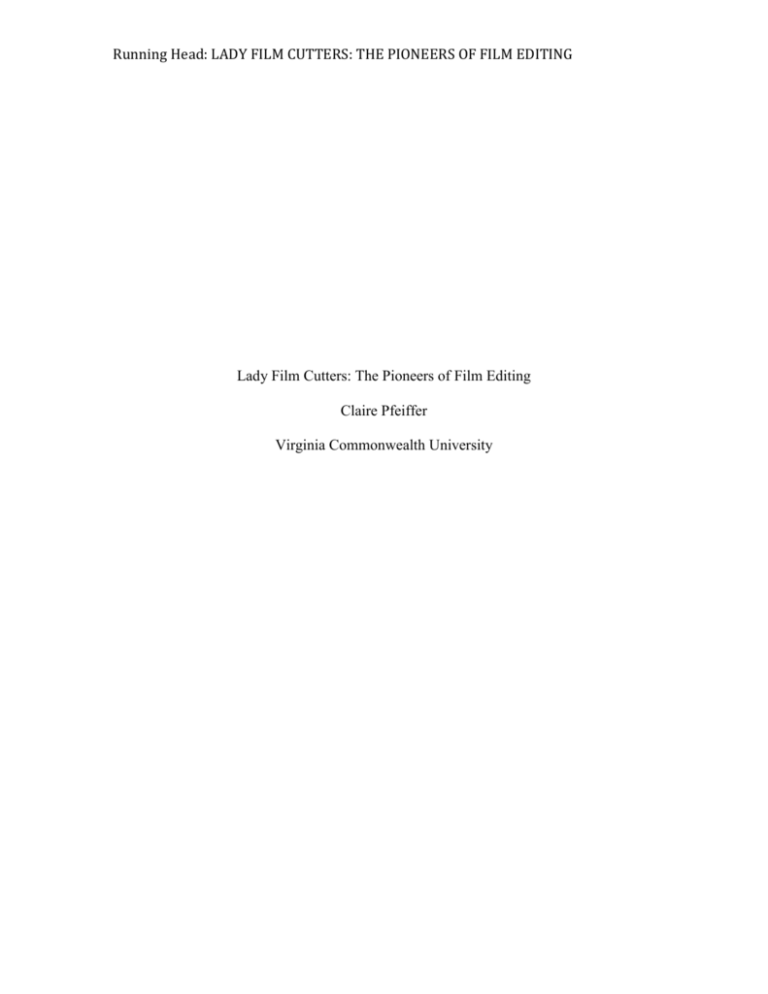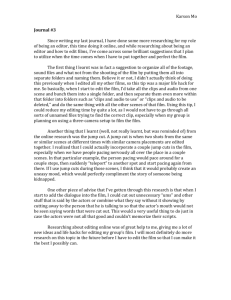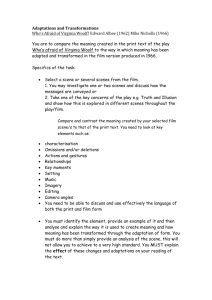The Pioneers of Film Editing
advertisement

Running Head: LADY FILM CUTTERS: THE PIONEERS OF FILM EDITING Lady Film Cutters: The Pioneers of Film Editing Claire Pfeiffer Virginia Commonwealth University LADY FILM CUTTERS: THE PIONEERS OF FILM EDITING Lady Film Cutters: The Pioneers of Film Editing Introduction Film editors are the best-kept secret of the movies. Editors literally manipulate time and space to create the illusion of cinema. Initially, the majority of film cutters were women. However, following the rise of talkies1, editing evolved into a creative profession instead of a secretarial duty, and as men flocked to the field, women were pushed out. Currently, the vast majority of Hollywood’s editors are men. Still, women played a large roll in establishing the principles of film editing. Margaret Booth, Dede Allen, Sally Menke and Thelma Schoonmaker are a few of the most influential editors of all time. Women also have innate gender traits, such as empathy and nurture that make them more suited for editing film. Despite the fact that women left a large impact on the craft of film editing and are naturally better at editing film, men now dominate Hollywood’s editing rooms because major Hollywood studios refuse to hire women. Lady film cutters are the pioneers of the craft of film editing and the lack of female film editors today has caused a stand still in creative innovation in Hollywood film editing. History of Film Editing and Sound Before the invention of talkies, the majority of film editors were women. Film editing was seen as a secretarial job and often compared to knitting, sewing or dressmaking. In, The Cutting Edge (2004), Walter Murch2 states, “It was something like tapestry, sewing that you took these pieces of fabric, which is what films are, and you put them together." The first editors were called “cutters” because they literally cut the film 1 Sound-synced films 2 Walter Murch edited Apocalypse Now and The Godfather: Part I & 2 LADY FILM CUTTERS: THE PIONEERS OF FILM EDITING by hand. Cutters looked at the film by holding it up to the light, then they literally cut and pasted the film together and checked their work by running it through a projector. These cutters were considered hands for hire rather than creative contributors and, most of the time, they didn’t even receive screen credit (Hatch, 2013). Sound was introduced to movies in the 1930s and it drastically changed filmmaking. Sound was more complicated and was seen as a “manly” profession similar to engineering. According to Murch, “Sound was somehow a ‘man’ thing – it was electric” (2002). As men flocked to editing, women disappeared. A Los Angeles Times Article (1940) declared “lady film cutters a vanishing profession” and places the blame on male editors – the articles states, “women cutters are resented by their male coworkers. At any rate, you aren’t likely to see their ranks increase as time goes on” (C3). The article also claims that cause of vanishing lady film cutters is because it takes 7 years of school to become an editor and insinuates that women don’t have time for a lengthy education because they are expected to wed and bear children. It was after the introduction of sound that producer, Irving Thalberg, started calling cutters, “film editors” (Hatch, 2013). Early cutters were considered hands for hire rather than creative partners in the filmmaking process, however, due to the digital revolution, editors are now key creative collaborators in the filmmaking process. Editors manipulate time and space – they can slow or speed up time and the timing of a cut can emotionally impact the audience. Editors are experts at invisibility and often compared to magicians. The Hollywood style of editing relies on the “invisible cut” which is a cut that always makes action appear continuous and fluid. Unfortunately, the invisible style of editing causes editors to go unnoticed and become underappreciated and many novice LADY FILM CUTTERS: THE PIONEERS OF FILM EDITING film cutters and editors never received the screen credits they deserved. (The Cutting Edge, 2004). The Pioneers In 1926, the position of cutting negatives and assembling reels was held almost entirely by young working-class women. According to Hatch (2013), “Out of the ranks of these film joiners and negative cutters emerged a handful of women who would help to develop the editing techniques that would become the hallmark of Hollywood’s visual style” So, despite the drastic decrease of female editors subsequent to the 1930s, many of the most iconic and influential film editors of all time were, and still are, women. Among the pioneers of film editing are Margaret Booth, Dede Allen, Viola Lawrence, Blanche Sewell and Anne Bauchens - these talented women established the Hollywood editing style. Margaret Booth began her career as a negative cutter for D.W. Griffith. According to Hatch (2013), “the job of a negative cutter was difficult, time-consuming, and intricate, which perhaps explains why it fell so often to women.” After Griffith closed his L.A. studio, Booth began working at Metro-Goldwyn-Mayer for Irving Thalberg. Booth worked as the supervising editor for MGM studios for 30 years. Director Sidney Lumet is quoted saying, “When I complete a film for Metro, I have to get blood on the floor to protect it from a lady named Margaret Booth, who I’m sure none of you have ever head of. She was Irving Thalberg’s cutter and to this day she checks every movie made for MGM and can stop you at any point, call off your mix and re-edit herself. She owns your negative” (Reynolds, 1998). In Booth’s essay, “The Cutter” she discusses the importance of cutting to a close up during a monologue to stress the LADY FILM CUTTERS: THE PIONEERS OF FILM EDITING importance of the dialogue as well as the importance of a distinctive rhythm when editing. “The Cutter” established many key editing principles that are still used in Hollywood today (Hatch, 2013). Dede Allen started her career at Columbia pictures as a messenger, was promoted to sound cutter, then assistant editor and finally to film editor. Eventually, Allen was hired as the head of post-production at Warner Brothers Studios. She is known for editing The Breakfast Club, Bonnie and Clyde and The Addams Family. Allen has been nominated for three Oscars but has never received one (Dede Allen, n.d.). In, The Cutting Edge (2004) Allen discuses her style, “A master shot had to come first and then if you had an over-shoulder you went to the over-shoulder. You never went to the close-up till you'd done the whole dance, coming from far to close. For instance, if you were going to have a transition from one place to the next it would be done with a dissolve.” Allen brought many Russian and German editing techniques to Hollywood. Female film editors remained prominent through the 1940s and 50s. Viola Lawrence, Blanche Sewell and Anne Bauchens are all iconic Hollywood film editors who continued editing long after the integration of sound. Lawrence edited Goldwyn’s first sound film and continued editing until the 1950s. Sewell edited MGM’s first sound film and continued editing until the late 1940s. Bauchens edited for MGM until the late 1950s. These women continued to shape the style of Hollywood editing. However, according to Hatch (2013), “entry-level positions were now going to men more often than to women, and it would become increasingly difficult for women to work their way into the studios’ editing rooms.” Women in Hollywood LADY FILM CUTTERS: THE PIONEERS OF FILM EDITING Sally Menke is Quentin Tarantino’s editor – she edited Pulp Fiction, Inglorious Basterds, Kill Bill Vol. 1 & 2 and Reservoir Dogs which are arguably a few of the most successful movies of all time. In, The Cutting Edge Menke states, “I think editors play a big role with directors in giving them support, making them feel like they can look at something that may have trouble or problems and be comfortable enough so that they can approach these problems.” She emphasizes the importance of getting the audience emotionally invested in the story. Thelma Schoonmaker is the most successful female film editor in Hollywood today - she is the only female to win an Oscar for Best Film Editing since 2001. Her first Oscar was for her spectacular cut of, Raging Bull (Thelma Schoonmaker, n.d.). Schoonmaker began editing during the cinema verite3 period of documentary filmmaking and she claims it heavily influenced her editing style. In The Cutting Edge (2004), she discusses how her years of experience editing documentary footage helped her edit Martin Scorsese’s heavily improvised films like Raging Bull and Goodfellas. Schoonmaker compares editing these improvisational films to assembling a jigsaw puzzle and explains it was very time consuming. Bette Davis is a famous and talented actress – her filmography includes more than 120 credits. She has been nominated for an Oscar eleven times, but only won twice for her performance in Jezebel (1938) and in Dangerous (1936.) Davis was the first Warner 3 Cinema Verite is a style of documentary filmmaking invented by Jean Rouch, inspired by Vertov’s theory of Kino-Pravda (Kino-Pravda roughly translates to film truth) in which the subject and the audience become unaware of the camera’s presence. LADY FILM CUTTERS: THE PIONEERS OF FILM EDITING Brother’s actress to win an Oscar and she is often referred to as, “The Fifth Warner Brother” (Bette Davis, n.d.). In October 1941, Bette Davis became the first female president of the Academy of Motion Picture Arts and Sciences. However, “she resigned less than two months later, publicly declaring herself too busy to fulfill her duties as president while angrily protesting in private that the Academy had wanted her to serve as a mere figurehead” (Bette Davis, n.d.). Davis passed away in 1989 – her tombstone reads, “She did it the hard way” (Bette Davis, n.d.). Gender Traits Women have gender assumed traits that make them more suited for editing film. Research from the Scandinavian Journal of Psychology as well as Neuroreport suggests that women are innately more empathetic than men. One of the many tasks of an editor is to choose the shot with the most convincing and fitting emotion. Since women are tuned to reading emotions and are naturally more empathetic, they are better able to choose the shots that are more emotionally appropriate for the scene. Booth describes a females unique emotional perspective when viewing a film as bringing a, “women’s eye view” to the editing room. According to Hatch (2013), an article in the Motion Picture Magazine from 1925 read: Among the greatest ‘cutters’ and film editors are women. They are quick and resourceful. They are also ingenious in their work and usually have a strong sense of what the public wants to see. They can sit in a stuffy cutting room and see themselves looking at the picture before an audience. LADY FILM CUTTERS: THE PIONEERS OF FILM EDITING Quentin Tarantino prefers a female editor because he believes women to be more nurturing and less demanding than men. Louann Brizendine’s4 book, The Female Brain discusses how the physical and hormonal composition of the female brain makes them innately more nurturing than men. In, The Cutting Edge, Tarantino discusses his relationship with Sally Menke, “ When I was doing my first movie, the only thing I knew is I wanted a female editor. (…) They wouldn’t try to be winning their way just to win their way. They wouldn’t be trying to shove their agenda or win their battles with me. They would be nurturing me through this process.” In fact, editors are often compared not only to dressmakers and librarians, but also midwifes. In this scenario, the director is giving birth to the film and the editor is there to help the film be born without incident. According to Reynolds (1998), “The director is the proud father standing on the porch. The midwife merely helped to avoid any tragic accidents.” Male Dominated Hollywood There is a large gender gap in Hollywood and men hold the majority of above the line positions5. The problem rests within the 6 major studios that dominate the box office: Warner Brothers Pictures (Time Warner), Universal Pictures (NBC Universal/Comcast), Walt Disney Pictures (Disney), Paramount Pictures (Viacom), Sony Pictures and 20th Century Fox. These six major studios are known for their lack of female screenwriters, directors, producers and editors. In the last five years, a woman directed only 4.7% of feature films released by a major studio. The lack of female filmmakers creates a 4 Louann Brizendine M.D. is a neuropsychiatrist and the author of two novels: The Female Brain and The Male Brain. 5 Above the line positions include Executive Producers, Producers and the Director. LADY FILM CUTTERS: THE PIONEERS OF FILM EDITING representational ghetto for women within Hollywood (Dargis, 2015). The Director’s Guild of America is aware of this gender gap and encourages production companies to interview more women and possibly initiate “set-asides” for female directors. In 1983, after many failed attempts to persuade major studios, Michael Franklin6 filed a classaction lawsuit against three major studios. Unfortunately, due to various legal requirements, the judge refused to assign to hear the case. Since then, the DGA has made many crucial efforts to expand filmmaking opportunities in Hollywood to women. However, women remain a minority in Hollywood and it seems legal action is necessary (Glese, 2014). European Model In the realm of independent and foreign filmmaking, the majority of editors are still women. Women were able to establish themselves as editors due to the informality of early European cinema. They learned editing skills while working because specific qualifications weren’t required. The rise of sound did not affect European cinema like it did to Hollywood. When sound emerged in Europe, film editing was still seen as a timeconsuming secretarial job and was evaded by men, which allowed female editors the opportunity to conquer sound technology. Jean-Luc Godard7 is often quoted saying, “tourner est masculin, monter feminin," which translates to, “shooting is masculine, editing is femininea” (Reynolds, 1998). 6 Michael Franklin is the National Executive Secretary of the Directors Guild of America. 7 Jean-Luc Godard is a famous French filmmaker known for directing Pierrot Le Fou and Vivre Sa Vie. LADY FILM CUTTERS: THE PIONEERS OF FILM EDITING Discussion Hollywood needs female editors to maintain and advance the quality of film editing as a craft. Women are the pioneers of Hollywood’s editing style - without the first female film cutters, film editing in Hollywood wouldn’t exist as it is today. Viola Lawrence, Blanche Sewell, Anne Bauchens, Margaret Booth and Dede Allen established the very principles of cutting and editing films in Hollywood. Consequently, the recent lack of female film editors is affecting the progression of Hollywood’s editing style. Women are better equipped to edit film because they are intrinsically empathetic and nurturing and now, without “a women’s eye,” Hollywood editing has become lazy and increasingly hollowed of emotion and meaning – the cuts barely even match anymore. The lack of female editors in Hollywood today is because the six major studios refuse to hire more women. So, in order to ensure women have an equal opportunity to be filmmakers in Hollywood, legal action must be taken. It may be argued that the decline of female film editors is not an issue that calls for legal action, however the lack of female editors widens the gender gap that exists within Hollywood. Without female editors, directors, screenwriters and producers, women appear less and less on the Hollywood screen and are increasingly sexualized and objectified by the six major studios. According to Dargis (2015), “In 2012, only 28.4 percent of on-screen speaking characters in the top 100 (box-office domestic releases) were women.” Women have lost their voice in Hollywood cinema. Cinema is a powerful media that affects the people in world around it. The lack of a female voice in Hollywood is harmful to our societies perception of women and gender equality. Therefore, the large gender gap within Hollywood needs to be addressed immediately. LADY FILM CUTTERS: THE PIONEERS OF FILM EDITING References Bette Davis. (n.d.). IMBD.com. Retrieved February 25, 2015. http://www.imdb.com/name/nm0000012/ The Cutting Edge: The Magic of Movie Editing [Motion picture on DVD]. (2004). Distributed by Warner Home Video. https://www.youtube.com/watch?v=U76MBDKQe8s Dargis, M. (2015, January 21). Lights, Camera, Taking Action. The New York Times. Retrieved February 23, 2015. http://www.nytimes.com/2015/01/25/movies/onmany-fronts-women-are-fighting-for-better-opportunity-in-hollywood.html?_r=0 Dede Allen. (n.d.). IMBD.com. Retrieved February 25, 2015. http://www.imdb.com/name/nm0020441/ Glese, M. (2014, January 20). To Sue Or Not to Sue: What History Teaches Us About Equality in Hollywood. Retrieved April 20, 2015, from http://blogs.indiewire.com/womenandhollywood/to-sue-or-not-to-sue-a-lessonfrom-history-for-women-directors Hatch, K. (2013, September 27). Cutting Women: Margaret Booth and Hollywood’s Pioneering Female Film Editors. Retrieved February 28, 2015. https://wfpp.cdrs.columbia.edu/essay/cutting-women/ Murch, W., & Ondaatje, M. (2002). The conversations: Walter Murch and the art of editing film. Toronto: Vintage Canada. https://books.google.com/books?hl=en&lr=&id=VRS6S1OXdwUC&oi=fnd&pg= PP2&dq=women+film+editing&ots=MD- LADY FILM CUTTERS: THE PIONEERS OF FILM EDITING Is2fta1&sig=HvkwpKM0agBkYiVvaKmgMO5lUUk#v=onepage&q=women&f= false Reynolds, S. (1998). The face on the cutting-room floor: women editors in the French cinema of the 1930s. Labour History Review (Maney Publishing), 63(1), 66-82. http://web.a.ebscohost.com/ehost/detail/detail?sid=826cb0c2-3972-4420-9afbe15b0736f214%40sessionmgr4005&vid=0&hid=4107&bdata=JkF1dGhUeXBlP WlwLHVybCxjb29raWUsdWlkJnNpdGU9ZWhvc3QtbGl2ZSZzY29wZT1zaXRl #db=a9h&AN=4049823 Scheuer, Philip K. “Lady Film Cutters: A Vanishing Profession.” Los Angeles Times (21 April 1940): C3. (Anne Bauchens, Blanche Sewell, Viola Lawrence). http://3to1z93m5aspz1tlz1zcsjta2m.wpengine.netdna-cdn.com/clairepfeiffer/wpcontent/uploads/sites/642/2015/03/VanishingProfession-1.pdf Thelma Schoonmaker. (n.d.) IMBD.com. Retreived February 25, 2015. http://www.imdb.com/name/nm0774817/ Welse, E. (2006, August 22). Maybe we are different: New book argues female brain wired to nurture - USATODAY.com. Retrieved April 20, 2015, from http://usatoday30.usatoday.com/tech/science/discoveries/2006-08-21-femalebrain_x.htm






